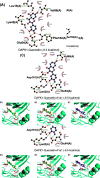In Silico Prediction of Quercetin Analogs for Targeting Death-Associated Protein Kinase 1 (DAPK1) Against Alzheimer's Disease
- PMID: 38752632
- PMCID: PMC11451310
- DOI: 10.2174/1570159X22666240515090434
In Silico Prediction of Quercetin Analogs for Targeting Death-Associated Protein Kinase 1 (DAPK1) Against Alzheimer's Disease
Abstract
Alzheimer's Disease (AD) is a progressive neurodegenerative disorder that greatly affects the health and life quality of the elderly population. Existing drugs mainly alleviate symptoms but fail to halt disease progression, underscoring the urgent need for the development of novel drugs. Based on the neuroprotective effects of flavonoid quercetin in AD, this study was designed to identify potential AD-related targets for quercetin and perform in silico prediction of promising analogs for the treatment of AD. Database mining suggested death-associated protein kinase 1 (DAPK1) as the most promising AD-related target for quercetin among seven protein candidates. To achieve better biological effects for the treatment of AD, we devised a series of quercetin analogs as ligands for DAPK1, and molecular docking analyses, absorption, distribution, metabolism, and excretion (ADME) predictions, as well as molecular dynamics (MD) simulations, were performed. The energy for drug-protein interaction was predicted and ranked. As a result, quercetin-A1a and quercetin-A1a1 out of 19 quercetin analogs exhibited the lowest interaction energy for binding to DAPK1 than quercetin, and they had similar dynamics performance with quercetin. In addition, quercetin-A1a and quercetin-A1a1 were predicted to have better water solubility. Thus, quercetin-A1a and quercetin-A1a1 could be promising agents for the treatment of AD. Our findings paved the way for further experimental studies and the development of novel drugs.
Keywords: Alzheimer’s disease (AD); In silico prediction; death-associated protein kinase 1 (DAPK1); neurodegenerative disease.; quercetin; quercetin analogs.
Conflict of interest statement
The authors declare no conflict of interest, financial or otherwise.
Figures





Similar articles
-
Unraveling the therapeutic potential of quercetin and quercetin-3-O-glucuronide in Alzheimer's disease through network pharmacology, molecular docking, and dynamic simulations.Sci Rep. 2024 Jun 27;14(1):14852. doi: 10.1038/s41598-024-61779-9. Sci Rep. 2024. PMID: 38937497 Free PMC article.
-
Role of death-associated protein kinase 1 (DAPK1) in retinal degenerative diseases: an in-silico approach towards therapeutic intervention.J Biomol Struct Dyn. 2024 Jul;42(11):5686-5698. doi: 10.1080/07391102.2023.2227720. Epub 2023 Jun 30. J Biomol Struct Dyn. 2024. PMID: 37387600
-
Identification of potential death-associated protein kinase-1 (DAPK1) inhibitors by an integrated ligand-based and structure-based computational drug design approach.J Biomol Struct Dyn. 2023 Dec;41(20):10785-10797. doi: 10.1080/07391102.2022.2158935. Epub 2022 Dec 28. J Biomol Struct Dyn. 2023. PMID: 36576199
-
Death-Associated Protein Kinase 1 as a Promising Drug Target in Cancer and Alzheimer's Disease.Recent Pat Anticancer Drug Discov. 2019;14(2):144-157. doi: 10.2174/1574892814666181218170257. Recent Pat Anticancer Drug Discov. 2019. PMID: 30569876 Free PMC article. Review.
-
DAPK1: a Novel Pathology and Treatment Target for Alzheimer's Disease.Mol Neurobiol. 2019 Apr;56(4):2838-2844. doi: 10.1007/s12035-018-1242-2. Epub 2018 Jul 31. Mol Neurobiol. 2019. PMID: 30062675 Review.
Cited by
-
Quercetin and Nano-Derivatives: Potential and Challenges in Cancer Therapy.Int J Nanomedicine. 2025 May 24;20:6701-6720. doi: 10.2147/IJN.S509877. eCollection 2025. Int J Nanomedicine. 2025. PMID: 40444010 Free PMC article. Review.
-
In Silico Analysis of s-DAPK-1: From Structure to Function and Regulation.Curr Issues Mol Biol. 2025 Jun 4;47(6):416. doi: 10.3390/cimb47060416. Curr Issues Mol Biol. 2025. PMID: 40699815 Free PMC article.
References
-
- Nichols E., Szoeke C.E.I., Vollset S.E., Abbasi N., Abd-Allah F., Abdela J., Aichour M.T.E., Akinyemi R.O., Alahdab F., Asgedom S.W., Awasthi A., Barker-Collo S.L., Baune B.T., Béjot Y., Belachew A.B., Bennett D.A., Biadgo B., Bijani A., Bin Sayeed M.S., Brayne C., Carpenter D.O., Carvalho F., Catalá-López F., Cerin E., Choi J-Y.J., Dang A.K., Degefa M.G., Djalalinia S., Dubey M., Duken E.E., Edvardsson D., Endres M., Eskandarieh S., Faro A., Farzadfar F., Fereshtehnejad S-M., Fernandes E., Filip I., Fischer F., Gebre A.K., Geremew D., Ghasemi-Kasman M., Gnedovskaya E.V., Gupta R., Hachinski V., Hagos T.B., Hamidi S., Hankey G.J., Haro J.M., Hay S.I., Irvani S.S.N., Jha R.P., Jonas J.B., Kalani R., Karch A., Kasaeian A., Khader Y.S., Khalil I.A., Khan E.A., Khanna T., Khoja T.A.M., Khubchandani J., Kisa A., Kissimova-Skarbek K., Kivimäki M., Koyanagi A., Krohn K.J., Logroscino G., Lorkowski S., Majdan M., Malekzadeh R., März W., Massano J., Mengistu G., Meretoja A., Mohammadi M., Mohammadi-Khanaposhtani M., Mokdad A.H., Mondello S., Moradi G., Nagel G., Naghavi M., Naik G., Nguyen L.H., Nguyen T.H., Nirayo Y.L., Nixon M.R., Ofori-Asenso R., Ogbo F.A., Olagunju A.T., Owolabi M.O., Panda-Jonas S., Passos V.M.A., Pereira D.M., Pinilla-Monsalve G.D., Piradov M.A., Pond C.D., Poustchi H., Qorbani M., Radfar A., Reiner R.C., Jr, Robinson S.R., Roshandel G., Rostami A., Russ T.C., Sachdev P.S., Safari H., Safiri S., Sahathevan R., Salimi Y., Satpathy M., Sawhney M., Saylan M., Sepanlou S.G., Shafieesabet A., Shaikh M.A., Sahraian M.A., Shigematsu M., Shiri R., Shiue I., Silva J.P., Smith M., Sobhani S., Stein D.J., Tabarés-Seisdedos R., Tovani-Palone M.R., Tran B.X., Tran T.T., Tsegay A.T., Ullah I., Venketasubramanian N., Vlassov V., Wang Y-P., Weiss J., Westerman R., Wijeratne T., Wyper G.M.A., Yano Y., Yimer E.M., Yonemoto N., Yousefifard M., Zaidi Z., Zare Z., Vos T., Feigin V.L., Murray C.J.L. Global, regional, and national burden of Alzheimer’s disease and other dementias, 1990-2016: A systematic analysis for the global burden of disease study 2016. Lancet Neurol. 2019;18(1):88–106. doi: 10.1016/S1474-4422(18)30403-4. - DOI - PMC - PubMed
-
- 2020 Alzheimer’s disease facts and figures. Alzheimers Dement. 2020:2020. - PubMed
MeSH terms
Substances
LinkOut - more resources
Full Text Sources
Medical
Research Materials

